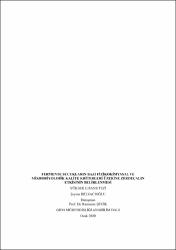Fermente sucukların bazı fizikokimyasal ve mikrobiyolojik kalite kriterleri üzerine zerdeçalın etkisinin belirlenmesi
Özet
Bu araştırmada, fermente Türk sucuğuna farklı oranda katılan zerdeçalın etkileri incelenmiştir. Zerdeçal seviyelerine göre %1.75 (Z1), %3.50 (Z2), %5.25 (Z3) ve zerdeçal içermeyen örnek kontrol (K) grubu olarak alınmıştır. 0. , 7. , 14. ve 21. günlerde çeşitli parametreler üzerine zerdeçalın etkileri belirlenmeye çalışılmıştır.
Su aktivitesi tüm günlerde en yüksek kontrol grubunda bulunurken, en düşük Z3 grubunda tespit edilmiştir. Sucuk örneklerinde 0. gün pH değeri 5.97-6.00 arasında değişirken, pH düşüşü olgunlaştırmanın 7. gününe kadar devam etmiş, 21. günde pH değerinin 5.07-5.60 arasında olduğu gözlenmiştir. pH değeri ilk gün dışındaki tüm günlerde en yüksek Z3 grubunda belirlenirken, diğer gruplarda değişkenlik göstermiştir.
Yağ, kül ve protein içerikleri kurumaya bağlı nem düzeylerinin azalması ile nisbi olarak artmıştır. Olgunlaştırma süresi boyunca analiz sonuçlarına göre, yağ miktarı %24.49-37.92, protein miktarı %20.62-26.85, kül miktarı %4.04-8.25 arasında değişim göstermiştir. Z3 grubundaki aw değerinin düşmesi, özellikle l* (parlaklık) değerini son iki haftada en düşük seviyeye çekerken, a* (kırmızılık) değeri genel olarak en yüksek kontrol gruplarında, b* (sarılık) değeri en yüksek Z3 gruplarında olduğu tespit edilmiştir. Elde edilen tekstür analiz sonuçlarının, zerdeçal seviyelerinden düzenli bir şekilde etkilenmediği söylenebilir.
Duyusal değerlendirmede %3.50 seviyesinde zerdeçal içeren Z2 sucuk örneği, en beğenilen sucuk grubunu oluşturmuştur.
Zerdeçal; gerek sahip olduğu antioksidan etkisi ve içerdiği renk pigmentleri nedeniyle fermente Türk sucuğunda renk parametresini etkilemiştir. Su aktivitesi üzerine de önemli derecede etkili olmakla beraber, diğer etkilerini belirlemek amacıyla yeni çalışmalar yapılmalıdır. In this research, the effects of turmeric added to fermented Turkish sausage in different percentages were investigated. As regards the turmeric levels, 1.75% (Z1), 3.50% (Z2), 5.25% (Z3) and the sample that does not contain turmeric was taken as the control group (K). The effects of turmeric on various parameters were tried to be determined on days 0, 7, 14 and 21.
Water activity was found to be highest in the control group and lowest in Z3 group. While the pH value of sausage samples ranged between 5.97-6.00 on the 0th day, the pH decrease continued until the 7th day of ripening and the pH value was observed between 5.07-5.60 on the 21st day. The pH value was found to be highest in the Z3 group on all days except the first day, but it was variable in the other groups.
Fat, ash and protein contents increased relatively with the decrease in moisture levels due to drying. According to the analysis results during the ripening period, the amount of fat varied between 24.49-37.92%, the amount of protein between 20.62-26.85%, and the amount of ash between 4.04-8.25%. The decrease in aw value in Z3 group decreased l * (brightness) value to the lowest level in the last two weeks, whereas a * (redness) value was found to be the highest in control groups and b * (yellowness) value was in the highest Z3 groups. It can be said that the results of the texture analysis obtained were not systematically affected by turmeric levels.
In the sensory evaluation, Z2 sausage sample containing 3.50% turmeric formed the most popular sausage group.
Turmeric has a definite effect on the color parameter of fermented Turkish sausage due to its antioxidant effect and color pigments. Although it has a significant effect on water activity as well, different studies should be carried out in order to determine the other effects.
Bağlantı
https://hdl.handle.net/11630/8453Koleksiyonlar
- Yüksek Lisans Tezleri [879]



















